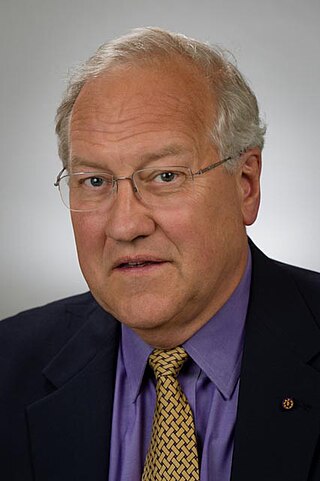Related Research Articles

The Biophysical Society is an international scientific society whose purpose is to lead the development and dissemination of knowledge in biophysics. Founded in 1958, the Society currently consists of over 7,000 members in academia, government, and industry. Although the Society is based in the United States, it is an international organization. Overseas members currently comprise over one third of the total.
Hans Neurath was a biochemist, a leader in protein chemistry, and the founding chairman of the Department of Biochemistry at the University of Washington in Seattle. He was born in Vienna, Austria, and received his doctorate in 1933 from the University of Vienna. He then studied in London and at the University of Minnesota. In 1938, he was appointed professor at Duke University, where he established a research program on the physical chemistry of proteins.
The Association of Biomolecular Resource Facilities (ABRF) is dedicated to advancing core and research biotechnology laboratories through research, communication, and education. ABRF members include over 2000 scientists representing 340 different core laboratories in 41 countries, including those in industry, government, academic and research institutions.

David S. Eisenberg is an American biochemist and biophysicist best known for his contributions to structural biology and computational molecular biology. He has been a professor at the University of California, Los Angeles since the early 1970s and was director of the UCLA-DOE Institute for Genomics & Proteomics, as well as a member of the California NanoSystems Institute (CNSI) at UCLA.
The Waterbird Society, formerly known as the Colonial Waterbirds Society, is a United States based ornithological society, focusing on the behavior, ecology, and conservation of waterbirds. It was founded in 1976 as the Colonial Waterbird Group, becoming the Colonial Waterbird Society in 1986 and acquiring its current name in 1999 to reflect an expanding interest in all waterbirds. The Society operates mostly on annual membership dues.
The Society of Multivariate Experimental Psychology (SMEP) is a small academic organization of research psychologists who have interests in multivariate statistical models for advancing psychological knowledge. It publishes a journal, Multivariate Behavioral Research.

Brian W. Matthews is a biochemist and biophysicist educated at the University of Adelaide, contributor to x-ray crystallographic methodology at the University of Cambridge, and since 1970 at the University of Oregon as Professor of Physics and HHMI investigator in the Institute of Molecular Biology.
Alanna Schepartz is an American professor and scientist. She is currently the T.Z. and Irmgard Chu Distinguished Chair in Chemistry at University of California, Berkeley. She was formerly the Sterling Professor of Chemistry at Yale University.
The Histochemical Society (HCS) is an academic society that was founded on March 24, 1950 at a meeting organized by Ralph D. Lillie of the National Institutes of Health. The idea for the Society arose during the 1949 Biological Stain Commission meeting at which a symposia encompassing anatomy, cytology, pathology and biochemistry was proposed by Lillie, Charles Leblond and Edward Dempsey. Lillie became the first editor of HCS's journal, Journal of Histochemistry and Cytochemistry.
Charles L. Brooks III is an American theoretical and computational biophysicist. He is the Cyrus Levinthal Distinguished University Professor of Chemistry and Biophysics, the Warner-Lambert/Park-Davis Professor of Chemistry, Professor of Biophysics and Chair of Biophysics at the University of Michigan.
James Hurley is a university professor known for his research into proteins. He won the 2014 Neurath Award from the Protein Society for a unique, recent contribution to basic science.

Christine Anne Orengo is a Professor of Bioinformatics at University College London (UCL) known for her work on protein structure, particularly the CATH database. Orengo serves as president of the International Society for Computational Biology (ISCB), the first woman to do so in the history of the society.

Robert A. Lamb was a British-American virologist. He was the Kenneth F. Burgess Professor at Northwestern University and since 1991, an investigator of the Howard Hughes Medical Institute. From 1990 to 2016, he was the John Evans Professor of Molecular and Cellular Biology at Northwestern University.

Tamir Gonen is an American structural biochemist and membrane biophysicist best known for his contributions to structural biology of membrane proteins, membrane biochemistry and electron cryo-microscopy (cryoEM) particularly in electron crystallography of 2D crystals and for the development of 3D electron crystallography from microscopic crystals known as MicroED. Gonen is an Investigator of the Howard Hughes Medical Institute, a professor at the University of California, Los Angeles, the founding director of the MicroED Imaging Center at UCLA and a Member of the Royal Society of New Zealand.
Finn Wold was a Norwegian-American biochemist known for the elucidation of structure-function relationships of proteins. Wold was a pioneer in the use of reagents to measure and decipher the structures of proteins. He reported one of the first examples of a transition state analogue, and was at the forefront of the design and use of affinity labels.
Robert Thomas Sauer is an American biochemist who is the Salvador E. Luria Professor of Biology at the Massachusetts Institute of Technology.
Peter Maxwell Howley is an American pathologist, virologist, and professor at Harvard Medical School. He has been president of the American Society for Virology and the American Society for Investigative Pathology and a co-editor of the Annual Review of Pathology: Mechanisms of Disease.
Robert Michael Stroud is a British biophysicist best known for his contributions to structural biology as means of determining the function of proteins, enzymes and integral membrane proteins. He was a professor of Chemistry at Caltech in the early 1970s and professor of Biochemistry and Biophysics, and of Pharmaceutical Chemistry at the University of California in San Francisco since 1976. He was elected to the National Academy of Sciences in 2003.

George N. Phillips, Jr. is a biochemist, researcher, and academic. He is the Ralph and Dorothy Looney Professor of Biochemistry and Cell Biology at Rice University, where he also serves as Associate Dean for Research at the Wiess School of Natural Sciences and as a professor of chemistry. Additionally, he holds the title of professor emeritus of biochemistry at the University of Wisconsin-Madison.
References
- ↑ Hermodson, Mark (1 August 2006). "The Protein Society: Celebrating 20 years in 2006—The founding and early years". Protein Science. 15 (8): 1811–1814. doi:10.1002/pro.151811. ISSN 1469-896X. PMC 2242597 . PMID 16877705.
- 1 2 "History". Protein Society. 2014. Retrieved 28 July 2014.
- ↑ "Protein Science Editorial Board". Protein Science. Retrieved 8 November 2024.